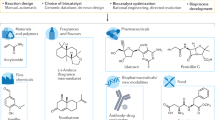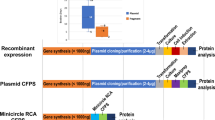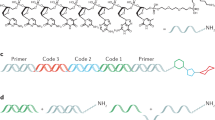Abstract
Current approaches to reaction discovery focus on one particular transformation. Typically, researchers choose substrates based on their predicted ability to serve as precursors for the target structure, then evaluate reaction conditions1,2,3,4,5,6 for their ability to effect product formation. This approach is ideal for addressing specific reactivity problems, but its focused nature might leave many areas of chemical reactivity unexplored. Here we report a reaction discovery approach that uses DNA-templated organic synthesis7,8,9,10 and in vitro selection to simultaneously evaluate many combinations of different substrates for bond-forming reactions in a single solution. Watson–Crick base pairing controls the effective molarities of substrates tethered to DNA strands; bond-forming substrate combinations are then revealed using in vitro selection for bond formation, PCR amplification and DNA microarray analysis. Using this approach, we discovered an efficient and mild carbon–carbon bond-forming reaction that generates an enone from an alkyne and alkene using an inorganic palladium catalyst. Although this approach is restricted to conditions and catalysts that are at least partially compatible with DNA, we expect that its versatility and efficiency will enable the discovery of additional reactions between a wide range of substrates.
This is a preview of subscription content, access via your institution
Access options
Subscribe to this journal
Receive 51 print issues and online access
$199.00 per year
only $3.90 per issue
Buy this article
- Purchase on Springer Link
- Instant access to full article PDF
Prices may be subject to local taxes which are calculated during checkout




Similar content being viewed by others
References
Stambuli, J. P. & Hartwig, J. F. Recent advances in the discovery of organometallic catalysts using high-throughput screening assays. Curr. Opin. Chem. Biol. 7, 420–426 (2003)
Reetz, M. T. Combinatorial and evolution-based methods in the creation of enantioselective catalysts. Angew. Chem. Int. Edn Engl. 40, 284–310 (2001)
Stambuli, J. P., Stauffer, S. R., Shaughnessy, K. H. & Hartwig, J. F. Screening of homogeneous catalysts by fluorescence resonance energy transfer. Identification of catalysts for room-temperature Heck reactions. J. Am. Chem. Soc. 123, 2677–2678 (2001)
Taylor, S. J. & Morken, J. P. Thermographic selection of effective catalysts from an encoded polymer-bound library. Science 280, 267–270 (1998)
Lober, O., Kawatsura, M. & Hartwig, J. F. Palladium-catalyzed hydroamination of 1,3-dienes: a colorimetric assay and enantioselective additions. J. Am. Chem. Soc. 123, 4366–4367 (2001)
Evans, C. A. & Miller, S. J. Proton-activated fluorescence as a tool for simultaneous screening of combinatorial chemical reactions. Curr. Opin. Chem. Biol. 6, 333–338 (2002)
Calderone, C. T., Puckett, J. W., Gartner, Z. J. & Liu, D. R. Directing otherwise incompatible reactions in a single solution by using DNA-templated organic synthesis. Angew. Chem. Int. Edn Engl. 41, 4104–4108 (2002)
Gartner, Z. J. & Liu, D. R. The generality of DNA-templated synthesis as a basis for evolving non-natural small molecules. J. Am. Chem. Soc. 123, 6961–6963 (2001)
Gartner, Z. J., Kanan, M. W. & Liu, D. R. Expanding the reaction scope of DNA-templated synthesis. Angew. Chem. Int. Edn Engl. 41, 1796–1800 (2002)
Rosenbaum, D. M. & Liu, D. R. Efficient and sequence-specific DNA-templated polymerization of peptide nucleic acid aldehydes. J. Am. Chem. Soc. 125, 13924–13925 (2003)
Li, X. & Liu, D. R. Stereoselectivity in DNA-templated organic synthesis and its origins. J. Am. Chem. Soc. 125, 10188–10189 (2003)
Wilson, D. S. & Szostak, J. W. In vitro selection of functional nucleic acids. Annu. Rev. Biochem. 68, 611–647 (1999)
Joyce, G. F. Directed evolution of nucleic acid enzymes. Annu. Rev. Biochem. 73, 791–836 (2004)
Rostovtsev, V. V., Green, L. G., Fokin, V. V. & Sharpless, K. B. A stepwise huisgen cycloaddition process: copper(I)-catalyzed regioselective ‘ligation’ of azides and terminal alkynes. Angew. Chem. Int. Edn Engl. 41, 2596–2599 (2002)
Wang, Q. et al. Bioconjugation by copper(I)-catalyzed azide–alkyne [3 + 2] cycloaddition. J. Am. Chem. Soc. 125, 3192–3193 (2003)
Burrows, C. J. & Muller, J. G. Oxidative nucleobase modifications leading to strand scission. Chem. Rev. 98, 1109–1152 (1998)
Kramer, M. F. & Coen, D. M. in Current Protocols in Molecular Biology Vol. 2 (eds Ausubel, F. M. et al.) 15.1.1–15.1.3 (Wiley, New York, 2001)
Bailey, P. D., Collier, I. D. & Morgan, K. M. in Comprehensive Organic Functional Group Transformations Vol. 5 (eds Katritzky, A. R., Meth-Cohn, O. & Rees, C. W.) 257–307 (Pergamon, New York, 1995)
Tsuji, J. Palladium Reagents and Catalysts (Wiley, New York, 1995)
Heck, R. F. Palladium-catalyzed vinylation of organic halides. Org. React. 27, 345–390 (1982)
Li, C.-J. & Chan, T.-H. Organic Reactions in Aqueous Media (Wiley, New York, 1997)
Miyaura, N. & Suzuki, A. Palladium-catalyzed cross-coupling reactions of organoboron compounds. Chem. Rev. 95, 2457–2483 (1995)
Crabtree, R. H. The Organometallic Chemistry of the Transition Metals (Wiley, New York, 2001)
Smidt, J. et al. Olefinoxydation mit palladiumchlorid-katalysatoren. Angew. Chem. 74, 93–102 (1962)
Smidt, J. et al. Katalytische umsetzungen von olefinen an platinmetall-verbindungen: das consortium-verfahren zur herstellung von acetaldehyd. Angew. Chem. 71, 176–182 (1959)
Wadsworth, W. S. J. & Emmons, W. D. Utility of phosphonate carbanions in olefin synthesis. J. Am. Chem. Soc. 83, 1733–1738 (1961)
Staunton, J. & Weissman, K. J. Polyketide biosynthesis: a millennium review. Nat. Prod. Rep. 18, 380–416 (2001)
Kohli, R. M., Walsh, C. T. & Burkart, M. D. Biomimetic synthesis and optimization of cyclic peptide antibiotics. Nature 418, 658–661 (2002)
Breslow, R. Biomimetic chemistry and artificial enzymes: catalysis by design. Acc. Chem. Res. 28, 146–153 (1995)
Schultz, P. G. & Lerner, R. A. Completing the circle. Nature 418, 485 (2002)
Acknowledgements
We thank P. Kehayova for the initial analysis of early reaction discovery selections, and C. Bailey (Bauer Center for Genomics Research) for assistance with DNA microarray preparation and analysis. We thank DNA Software for assistance with screening coding and annealing sequences. This work was supported by the National Institutes of Health, the Office of Naval Research, and the Arnold and Mabel Beckman Foundation. M.W.K. and T.M.S. are NSF Graduate Research Fellows. M.M.R. is an NDSEG Graduate Research Fellow. K.S. is a Helen Hay Whitney Postdoctoral Research Fellow.
Author information
Authors and Affiliations
Corresponding author
Ethics declarations
Competing interests
D.R.L. owns shares of Ensemble Discovery, a new (and non-public) company that has licenced DNA-templated synthesis technologies from Harvard University.
Supplementary information
Rights and permissions
About this article
Cite this article
Kanan, M., Rozenman, M., Sakurai, K. et al. Reaction discovery enabled by DNA-templated synthesis and in vitro selection. Nature 431, 545–549 (2004). https://doi.org/10.1038/nature02920
Received:
Accepted:
Issue Date:
DOI: https://doi.org/10.1038/nature02920
This article is cited by
-
Strategies for developing DNA-encoded libraries beyond binding assays
Nature Chemistry (2022)
-
DNA-encoded chemistry: enabling the deeper sampling of chemical space
Nature Reviews Drug Discovery (2017)
-
Sulfamic acid-catalyzed multicomponent synthesis of 7-phenyl-7,12 dihydrobenzo(h)pyrido[2,3-b]naphthydrin-6(5H)-one derivatives: a green avenue
Research on Chemical Intermediates (2017)
-
Reversible trapping and reaction acceleration within dynamically self-assembling nanoflasks
Nature Nanotechnology (2016)
-
Chemistry: Why synthesize?
Nature (2015)
Comments
By submitting a comment you agree to abide by our Terms and Community Guidelines. If you find something abusive or that does not comply with our terms or guidelines please flag it as inappropriate.



